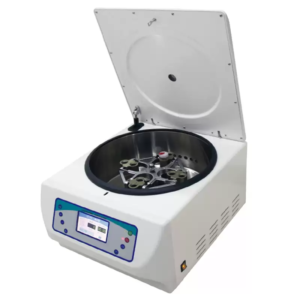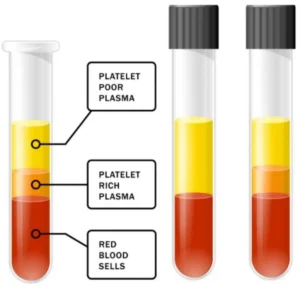Get a Quote
We will get in touch in 1 business day.
| Screen | LCD digital screen |
| Machine Body | Plastic and metal frame |
| Max. Speed | 5000rpm |
| Speed accuracy | ±20 rpm |
| Max. RCF | 4760xg |
| No1: Swing Rotor | 50mlx45000rpm4760xg(for 50ml syringe) |
| No2: Swing Rotor | 20mlx84000rpm3040xg(for 20ml syringe) |
| No3: Angle Rotor | 10mlx124500rpm3395xg(for 10ml syringe) |
| Timer range | 1~99min59s /continuous/short spin |
| Motor | Converter motor |
| Motor Power | 750W |
| Voltage | AC220V, 50Hz, 5A(Can be customized according to different countries) |
| Noise | <60db |
| Net weight. | 35kg |

The main applications of medical centrifuges include:
Blood separation: Medical centrifuges can be used to separate whole blood components such as red blood cells, platelets, and plasma. This is very important in clinical diagnosis, blood transfusion, hematology research, and so on.
Cell separation: Centrifuges can be used to separate different types of cells, such as white blood cells, lymphocytes, tumor cells, etc. This is crucial for areas such as cell biology research, cell therapy, and genetic engineering.
Sample preparation: Centrifuges can be used to prepare samples, such as precipitated cells, cell fragments, organelles, proteins, nucleic acids, etc., for subsequent experiments and analysis.
Drug development: Centrifuges can be used to isolate and purify drug candidates, drug metabolites, etc., for drug development and pharmacokinetic studies.
Clinical diagnosis: Centrifuges can be used for clinical diagnosis, such as separating sediment in urine, detecting pathogens, and determining biochemical indicators in serum.


Step 1: First of all, prepare all the consumables we need in the process of operation, including anticoagulant collection vessels, rubber tubes, disinfectant, cotton swabs, syringes, syringes, long needles, 30G needle fungal gauze, etc.
Step 2: Blood was drawn. Peripheral blood was collected by the conventional blood drawing process, about 10ml, mixed upside down and fully mixed with the anticoagulant in the blood collection tube.
Step 3: For the first centrifugation, put the collecting vessel into a centrifuge, preferably a tilt centrifuge. After increasing the slope, the platelets cover a large area and are easy to extract. The first centrifugal speed was 2500pm. After centrifugation, the blood vessels were taken out. At this time, obvious stratification could be seen, with serum in the upper layer, platelets in the middle, and red blood cells in the lower layer.
Step 4: For the first centrifugation, put the collecting vessel into a centrifuge, preferably a tilt centrifuge. After increasing the slope, the platelets cover a large area and are easy to extract. The first centrifugal speed was 2500pm. After centrifugation, the blood vessels were taken out. At this time, obvious stratification could be seen, with serum in the upper layer, platelets in the middle, and red blood cells in the lower layer.
Step 5: Second centrifugation. The second collection vessel was centrifuged again at 3200RPM for 8min. After centrifugation, the collection vessel was taken out.
Step 6: The remaining approximately PRP is extracted with a 1ml syringe, and the whole extraction process is completed.
We are a factory with over 20+ years of experience.
30% T/T in advance, and balance against the documents.
Yes, all accepted.
Our capacity can be 500,000PCS per day.
Yes, Sinymedical has a dedicated customer support team. You can reach them through the contact information provided on their website.

Medical Consumables Manufacturer Established 2003. High-end equipment, professional team, first-class service Sinymedical helps you simplify the process from import to sale. Let your medical consumables become high-quality products.
Copyright © 2025 Sinymedical PRP Tube | All Rights Reserved
We will get in touch in 1 business day.